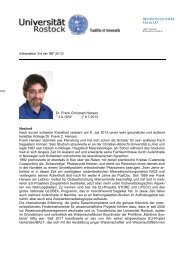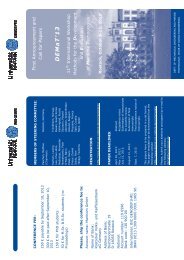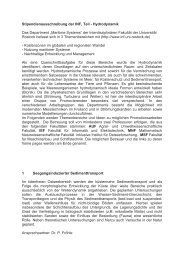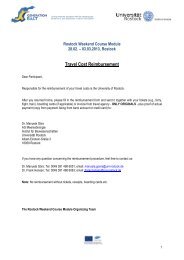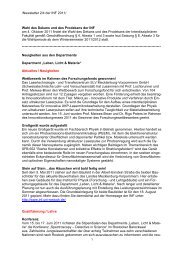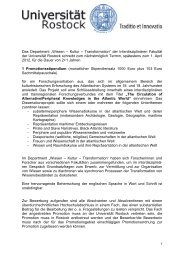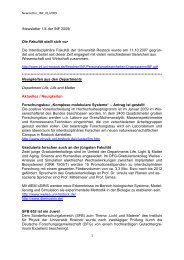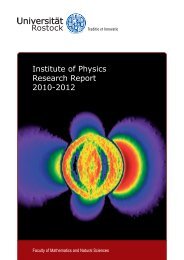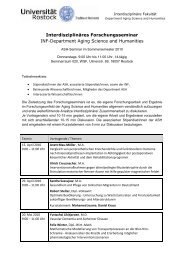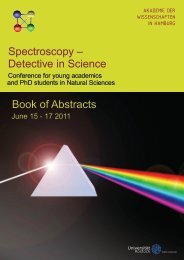Institute of Physics Research Report 2007-2009 - Universität Rostock
Institute of Physics Research Report 2007-2009 - Universität Rostock
Institute of Physics Research Report 2007-2009 - Universität Rostock
You also want an ePaper? Increase the reach of your titles
YUMPU automatically turns print PDFs into web optimized ePapers that Google loves.
<strong>Institute</strong> <strong>of</strong> <strong>Physics</strong><br />
<strong>Research</strong> <strong>Report</strong><br />
<strong>2007</strong>-<strong>2009</strong><br />
Faculty <strong>of</strong> Mathematics and Natural Sciences
4 Department <strong>of</strong> Science and<br />
Technology <strong>of</strong> Life, Light and<br />
Matter<br />
4.1 Overview<br />
In <strong>2007</strong>, established within the Faculty <strong>of</strong> Interdisciplinary <strong>Research</strong> <strong>of</strong> the University<br />
<strong>of</strong> <strong>Rostock</strong>, the Department “Science and Technology <strong>of</strong> Life, Light and<br />
Matter” (LLM) has been founded. Its activities search to connect scientific effort <strong>of</strong><br />
the faculties <strong>of</strong> natural sciences and mathematics, agriculture, engineering sciences<br />
as well as medicine. Three further departments “Maritime systems”, “Aging Sciences<br />
and Humanities” and “Knowledge - Culture – Transformation” together with<br />
LLM currently constitute the Interdisciplinary Faculty (INF), which is supported<br />
by the University and the state <strong>of</strong> Mecklenburg-Western Pomerania. Aim is to identify<br />
and strengthen fruitful research fields through an appointment policy that is<br />
consequently oriented towards pr<strong>of</strong>ile and strategy in order to foster international<br />
competitiveness.<br />
Fig. 4.1: Catalysis, Photonics, Medicine, and Simulation technology are in the core<br />
<strong>of</strong> the Department <strong>of</strong> Life, Light and Matter.<br />
175
4 Department <strong>of</strong> Science and Technology <strong>of</strong> Life, Light and Matter<br />
4.2 Program <strong>of</strong> the Department<br />
The department Life, Light and Matter aims at interdisciplinary research and training<br />
in the fields photon sciences, engineering and catalysis, regenerative medicine<br />
and numerical simulations. The program comprises activities within several faculties<br />
and institutes <strong>of</strong> <strong>Rostock</strong> University. Among those are the basic sciences chemistry,<br />
physics and mathematics, as well as the more applied mechanical and electronic<br />
engineering, informatics, and life sciences. In addition, the Leibniz-<strong>Institute</strong> for<br />
catalysis (LIKAT) as well as the Leibniz-<strong>Institute</strong> for atmospheric research (IAP)<br />
are significantly involved.<br />
The scope <strong>of</strong> the investigations reaches from fundamental problems like the interaction<br />
<strong>of</strong> light with matter via the development <strong>of</strong> chemical and agricultural as<br />
well as biologically relevant drug design for biomedical applications. Smart materials<br />
play an important role in all <strong>of</strong> these areas. One backbone <strong>of</strong> the Department<br />
LLM is research on the impact <strong>of</strong> atomic and molecular properties onto macroscopic<br />
systems. In particular, microscopic mechanisms, i.e. those on the atomic<br />
or nanometer-scale will be interrogated and ultimately be used for the controlled<br />
development and modification <strong>of</strong> new materials. These may be <strong>of</strong> importance in<br />
far-future applications like quantum computing (’quantum matter’) and the controlling<br />
<strong>of</strong> three-dimensional nerve cell growth as well as on current problems like<br />
biocompatibility. In several projects modern forms <strong>of</strong> light, e.g., laser pulses shaped<br />
in amplitude and phase, will be <strong>of</strong> use to reveal the microscopic dynamics and, at<br />
the same time, to steer the creation <strong>of</strong> desired structures.<br />
The University <strong>of</strong> <strong>Rostock</strong> already has established competences at the intersection<br />
<strong>of</strong> natural, engineering and life sciences. They serve as solid basis for the Department<br />
LLM, being a condensation nucleus <strong>of</strong> an interdisciplinary high-technology field.<br />
Moreover, as the research has many links to technical applications it bears potential<br />
for a sustainable future growth sector.<br />
Accompanied with the constitution <strong>of</strong> the department is the need for a specific education.<br />
Whereas the basic study period remains with the established departments <strong>of</strong><br />
the university, the specialization on topics <strong>of</strong> LLM occurs during the master studies<br />
and the PhD theses. There will be opportunities for advanced training <strong>of</strong> scientific<br />
and technical personal. Besides its focus onto natural and engineering sciences and<br />
on medicine, the department provides many possibilities for interactions with topics<br />
<strong>of</strong> social sciences and economics. Thus there is much room for collaborations with<br />
the other departments within the Interdisciplinary Faculty.<br />
176
4.3 Contribution <strong>of</strong> the <strong>Physics</strong> <strong>Institute</strong> to LLM<br />
4.3 Contribution <strong>of</strong> the <strong>Physics</strong> <strong>Institute</strong> to LLM<br />
Among the over 35 research groups within LLM, 10 belong to the <strong>Physics</strong> institute.<br />
These are:<br />
Pr<strong>of</strong>. Dr. Thomas Gerber<br />
<strong>Physics</strong> <strong>of</strong> Nano- and Biomaterials<br />
Pr<strong>of</strong>. Dr. Oliver Kühn<br />
Molecular Quantum Dynamics<br />
Pr<strong>of</strong>. Dr. Stefan Lochbrunner Dynamics <strong>of</strong> Molecular Systems<br />
Pr<strong>of</strong>. Dr. Franz-Josef Lübken Leibniz <strong>Institute</strong> for Atmospheric <strong>Physics</strong><br />
Pr<strong>of</strong>. Dr. Karl-Heinz Meiwes-Broer Clusters and Nanostructures<br />
Pr<strong>of</strong>. Dr. Fedor Mitschke<br />
Nonlinear Optics<br />
Pr<strong>of</strong>. Dr. Ronald Redmer<br />
Statistical <strong>Physics</strong><br />
Pr<strong>of</strong>. Dr. Heidi Reinholz<br />
Spectral lines <strong>of</strong> dense plasmas<br />
Pr<strong>of</strong>. Dr. Christoph Schick Polymer <strong>Physics</strong><br />
Pr<strong>of</strong>. Dr. Heinrich Stolz<br />
Semiconductor Optics<br />
4.4 Current Activities<br />
In the period under review one focal point <strong>of</strong> LLM has been the enhanced networking<br />
among the workgroups in different scientific disciplines. At first, partially language<br />
barriers had to be removed. At the same time the members had to recognize their<br />
own benefits when participating in this interdisciplinary effort. With strong support<br />
by the University and the local government PhD scholarship funds could be granted<br />
to 14 students. All <strong>of</strong> them work on interdisciplinary topics and are coached by two<br />
supervisors from separate institutes. Looking back it is a success that numerous<br />
personalities have made an application for admission in the department as well as<br />
have written down research subjects suitable to LLM. Members from 5 faculties<br />
as well as the IAP and LIKAT could be admitted thus after confirmation by the<br />
leading board <strong>of</strong> the Interdisciplinary Faculty and the rector <strong>of</strong> the University, Pr<strong>of</strong>.<br />
Schareck.<br />
LLM defines itself as a research department. Hence its main aim is the identification<br />
and establishment <strong>of</strong> topical research subjects in order to attract high-level<br />
scientists and enhanced third-party funding. In this respect the PhD scholarships<br />
serve as ‘glue money’ to strengthen initiatives setting up new research projects.<br />
Some major projects as well as few smaller ones could be either continued in the<br />
proximity <strong>of</strong> the department or be started. One major success has been the funding<br />
<strong>of</strong> a laboratory building specific for the Department LLM. Approved by the German<br />
Council <strong>of</strong> Science and Humanities (Wissenschaftsrat) the scientific building “Complex<br />
Molecular Systems” will provide additional 2400 sqm <strong>of</strong> extensively equipped<br />
space. The topical focus <strong>of</strong> LLM and the high standard <strong>of</strong> the contributing research<br />
groups made it possible to acquire 20 Mio. EUR funding for the new building and<br />
for equipment. With this an appropriate environment will be established for the<br />
interdisciplinary research and education in the Department LLM. Activities within<br />
177
4 Department <strong>of</strong> Science and Technology <strong>of</strong> Life, Light and Matter<br />
Fig. 4.2: Computer aided design <strong>of</strong> the scientific building “Complex Molecular Systems”;<br />
drawing by Gerber Architekten GmbH.<br />
the disciplines <strong>Physics</strong>, Chemistry, Biology, Medicine and Engineering will be bundled<br />
in order to pursue the research on complex molecular systems. A central topic<br />
is the analysis, control and design <strong>of</strong> systems which are governed through processes<br />
on the molecular level.<br />
Further larger projects with the contribution <strong>of</strong> LLM research groups include:<br />
• Collaborative <strong>Research</strong> Center DFG-SFB 652 “Strong correlations and collective<br />
effects in radiation fields: Coulomb systems, clusters and particles”, see<br />
the overview in this research report. This research is centered at the <strong>Institute</strong><br />
<strong>of</strong> <strong>Physics</strong>, with one project leader being from the Chemistry Department <strong>of</strong><br />
the University <strong>of</strong> <strong>Rostock</strong> and four project leaders from the <strong>Institute</strong> <strong>of</strong> <strong>Physics</strong><br />
<strong>of</strong> the University <strong>of</strong> Greifswald.<br />
• The Graduate School at the SFB 652 increases the communication among the<br />
PhD students within weekly colloquia, workshops, and other social activities.<br />
It strengthens the scientific abilities <strong>of</strong> the students by providing access to<br />
additional conferences, by being responsible for laboratory students, and by<br />
participating in the organization <strong>of</strong> the graduate school.<br />
• Collaborative <strong>Research</strong> Center DFG-TR 37 “Micro- and nanosystems in medicine<br />
– reconstruction <strong>of</strong> biologic functions”. This center is a joint project<br />
between the universities <strong>of</strong> Aachen, Hannover and <strong>Rostock</strong>. The <strong>Rostock</strong><br />
178
4.4 Current Activities<br />
side is mainly carried by the faculties <strong>of</strong> medicine, engineering and natural<br />
scientists. One project area comprises optical technologies, in particular laser<br />
technologies for the manipulation <strong>of</strong> cells and cell groups. Other projects<br />
include the generation, analysis and technical characterization <strong>of</strong> bioactive<br />
and nanostructured surfaces and particles to optimize their efficiency in the<br />
interaction with biological systems. Other central questions concern vascular<br />
illnesses and illnesses by eye and ear, and the development <strong>of</strong> new investigation<br />
methods in the areas <strong>of</strong> the microscopy and biocompatibility.<br />
Furthermore, physics research groups and members <strong>of</strong> the department are involved<br />
in two cutting-edge <strong>Research</strong> and Innovation Projects in East Germany<br />
(“Spitzenforschung in den Neuen Ländern”):<br />
– Regionale Entwicklung durch Medizintechnische Innovation und Spitzenforschung<br />
(Remedis). This collaborative project focuses onto the development<br />
<strong>of</strong> new implants for clinical applications. The consortium unites<br />
competence in the areas <strong>of</strong> the engineering sciences, medicine and natural<br />
sciences from the university. Other local, national and international<br />
institutes and companies are involved.<br />
– Light2Hydrogen - Energy for the future. This research project explores<br />
new ways for hydrogen generation, boosting efficiency using nanotechnology<br />
and other novel technologies for a post-oil society.<br />
A variety <strong>of</strong> additional smaller and larger research projects constitute interdisciplinary<br />
work connecting the <strong>Physics</strong> <strong>Institute</strong> with other institutes and<br />
groups. The Department LLM strives for increasing such concerted activities<br />
in order to strengthen the international competitiveness <strong>of</strong> the University <strong>of</strong><br />
<strong>Rostock</strong>.<br />
179
<strong>Universität</strong> <strong>Rostock</strong><br />
MATHEMATISCH-NATURWISSENSCHAFTLICHE FAKULTÄT<br />
Institut für Physik<br />
D 18051 <strong>Rostock</strong><br />
Fon + 49 (0)381 498-67 00<br />
Fax + 49 (0)381 498-67 02<br />
institut.physik@uni-rostock.de<br />
http://web.physik.uni-rostock.de



